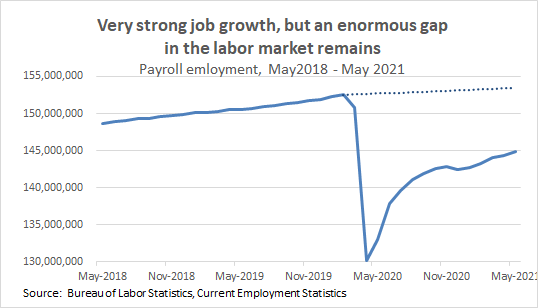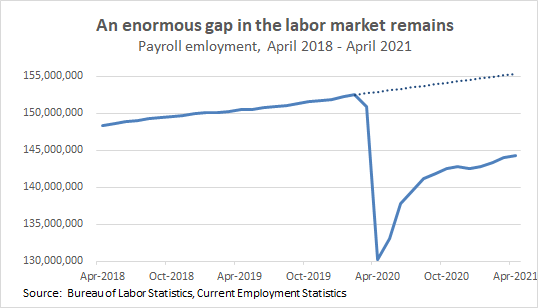
Last week 461,000 people applied for UI. This included 385,000 who applied for regular state UI (seasonally adjusted) and 76,000 who applied for Pandemic Unemployment Assistance (PUA). 1/ dol.gov/ui/data.pdf
Claims are steadily coming down as the labor market strengthens. The 461,000 who applied for UI last week was a decrease of 37,000 from the prior week. The 4-week moving average of total initial claims also decreased by 37,000. 2/
Total initial claims are now around 40% what they were the first week of March, just shy of three months ago. This is a remarkable improvement. 3/
However, total initial claims are still 2.5 times what they were before COVID. If you restrict this comparison to regular state claims—which is appropriate because we didn’t have PUA pre-COVID—initial claims are 2.1 times where they were before COVID. 4/
This chart shows continuing claims in all programs over time (latest data are for May 15th). Total continuing claims are steadily declining. The 4-wk moving average has come down by 3.5 million just since early March, but it’s still around 14 mil above where it was before COVID. 

Many are asking whether expanded unemployment benefits are damaging the labor market by keeping workers from taking jobs. THERE IS NO COMPELLING EVIDENCE OF THIS. This thread has some info showing that. 6/
https://twitter.com/hshierholz/status/1392273792626421760?s=20
Nonetheless, many republican-led states are preparing to cancel pandemic UI benefits. This will not just hurt workers who can’t find work or can’t work right now, it will hurt the economy in these states, b/c those benefits are supporting spending. It’s terrible economics. 7/
This excellent piece by @pelhamprog shows, by state, how many workers will be affected and how much money they (and their states) will lose if states cancel federal unemployment benefits. 8/ tcf.org/content/commen…
Note: the impact of states cancelling UI benefits is not yet showing up because the earliest termination date any of these states has announced is mid-June. 9/
• • •
Missing some Tweet in this thread? You can try to
force a refresh





